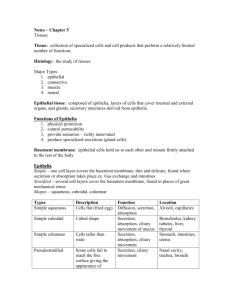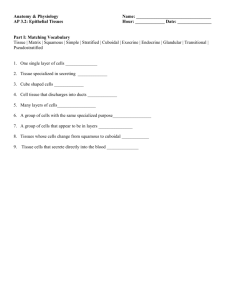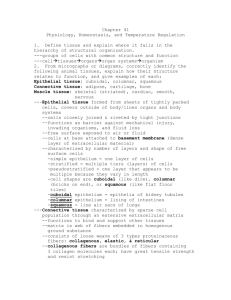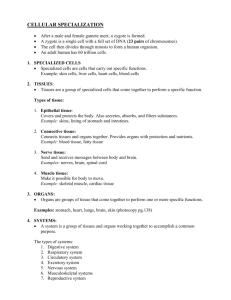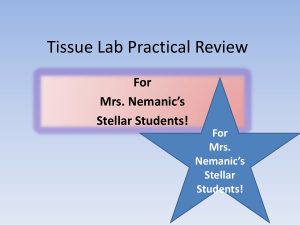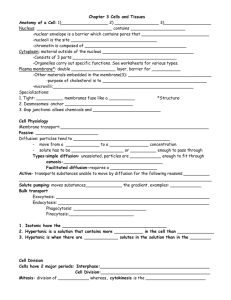Ch 2 – Chemistry Test Review Sheet
advertisement
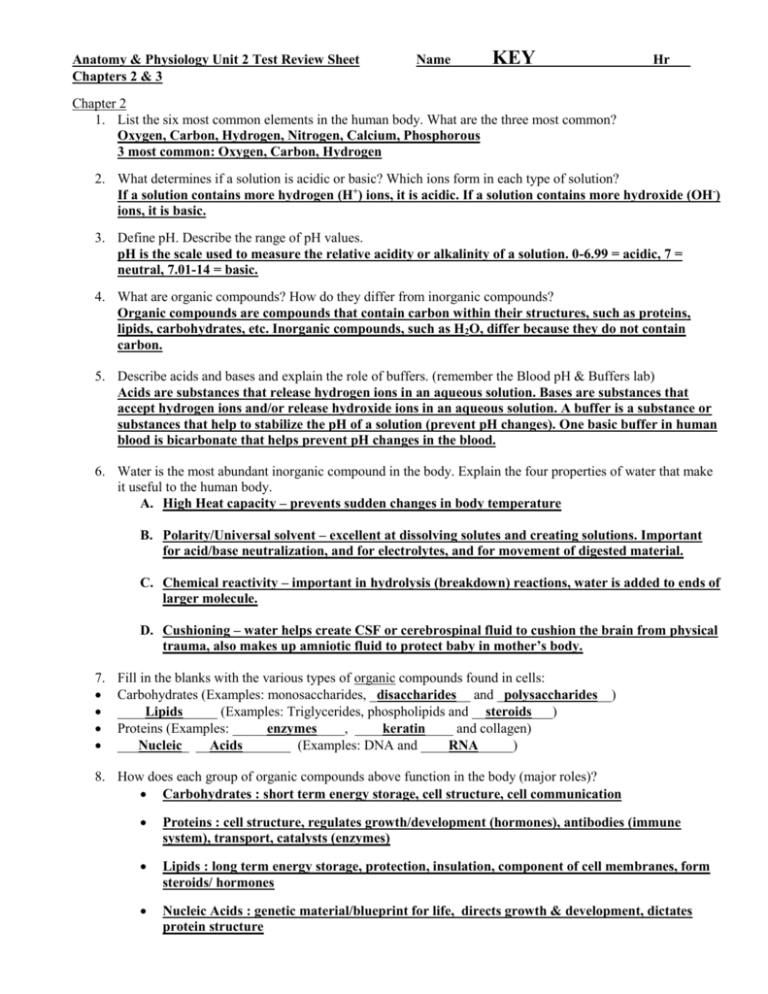
Anatomy & Physiology Unit 2 Test Review Sheet Chapters 2 & 3 Name______KEY_________________Hr___ Chapter 2 1. List the six most common elements in the human body. What are the three most common? Oxygen, Carbon, Hydrogen, Nitrogen, Calcium, Phosphorous 3 most common: Oxygen, Carbon, Hydrogen 2. What determines if a solution is acidic or basic? Which ions form in each type of solution? If a solution contains more hydrogen (H+) ions, it is acidic. If a solution contains more hydroxide (OH-) ions, it is basic. 3. Define pH. Describe the range of pH values. pH is the scale used to measure the relative acidity or alkalinity of a solution. 0-6.99 = acidic, 7 = neutral, 7.01-14 = basic. 4. What are organic compounds? How do they differ from inorganic compounds? Organic compounds are compounds that contain carbon within their structures, such as proteins, lipids, carbohydrates, etc. Inorganic compounds, such as H2O, differ because they do not contain carbon. 5. Describe acids and bases and explain the role of buffers. (remember the Blood pH & Buffers lab) Acids are substances that release hydrogen ions in an aqueous solution. Bases are substances that accept hydrogen ions and/or release hydroxide ions in an aqueous solution. A buffer is a substance or substances that help to stabilize the pH of a solution (prevent pH changes). One basic buffer in human blood is bicarbonate that helps prevent pH changes in the blood. 6. Water is the most abundant inorganic compound in the body. Explain the four properties of water that make it useful to the human body. A. High Heat capacity – prevents sudden changes in body temperature B. Polarity/Universal solvent – excellent at dissolving solutes and creating solutions. Important for acid/base neutralization, and for electrolytes, and for movement of digested material. C. Chemical reactivity – important in hydrolysis (breakdown) reactions, water is added to ends of larger molecule. D. Cushioning – water helps create CSF or cerebrospinal fluid to cushion the brain from physical trauma, also makes up amniotic fluid to protect baby in mother’s body. 7. Fill in the blanks with the various types of organic compounds found in cells: Carbohydrates (Examples: monosaccharides, _disaccharides__ and _polysaccharides__) ____Lipids_____ (Examples: Triglycerides, phospholipids and __steroids___) Proteins (Examples: _____enzymes____, ____keratin____ and collagen) ___Nucleic_ __Acids_______ (Examples: DNA and ____RNA_____) 8. How does each group of organic compounds above function in the body (major roles)? Carbohydrates : short term energy storage, cell structure, cell communication Proteins : cell structure, regulates growth/development (hormones), antibodies (immune system), transport, catalysts (enzymes) Lipids : long term energy storage, protection, insulation, component of cell membranes, form steroids/ hormones Nucleic Acids : genetic material/blueprint for life, directs growth & development, dictates protein structure 9. Explain how enzymes act as catalysts for chemical reactions and why they are important in the body. Enzymes act as catalysts by increasing the rate of chemical reactions in the body without becoming part of the product or being itself changed. When the substrate (reacting molecule) is bound to the active site of the enzyme, it undergoes structural changes that result in a new product. 10. Define Acidosis and Alkalosis and give examples of causes of each (use your glossary and index to help you!) Acidosis—a condition in which the blood has an excess of hydrogen ions and a decreased pH. Causes: too much carbon dioxide, lung disease, kidney disease, diabetes, dehydration, etc, Alkalosis—a condition in which the blood has a lower hydrogen ion concentration than normal, and an increased pH. Causes: too little carbon dioxide in the body, lung disease, liver disease, lack of oxygen 11. All enzymes are examples of what type of organic molecule? ______proteins___________________ 12. All enzyme names generally end in what suffix? ____-ase________________ 13. Which organic molecule is used for short term energy storage? ________carbohydrates________________ 14. Many carbohydrate names end in what suffix? ______-ose_____________ 15. Which organic molecule is used for long-term energy storage? ___lipids_________________________ 16. Which organic molecule is used as the base for building cholesterol and many steroids? ____lipids________ 17. Which organic molecule is used for genetic material? _____nucleic acid_______________ Chapter 3 and Lab Handouts 18. Cells in several layers are said to be ________stratified___________________ 19. Cells in single layers are said to be ______simple______________________ 20. Epithelial cells that are taller than wider are called ________columnar_______________________ 21. Another name for fatty tissue is __________adipose_____________________ 22. Flat epithelial cells are called ___________squamous____________________ 23. Involuntary muscle tissue that is unstriated would be called _________smooth muscle_________________ 24. Muscle tissue which is striated but involuntary would be called ______cardiac muscle__________________ 25. Most connective tissues are well vascularized, meaning they have a good blood supply. Which connective tissues represent an exception? ___dense connective (tendons & ligaments)_________________________ 26. What are the functions of adipose tissue? ___Stores fat, Protection of some organs, Protects the body from extremes of heat and cold_( Insulates the body) 27. The thin epithelium that lines a blood vessel or an air sac in the lungs (alveoli) is called: _____simple squamous__________________________ 28. The major type tissue that covers the body surfaces, lines its cavities and forms glands is the ______epithelial_________ tissue. 29. Which one of the following list of cells is not a type of epithelial cell? a) Stratified squamous b) Dense fibrous c) Pseudostratified columnar d) Simple cuboidal 30. Fill in the following tables with details about the tissue types listed. Epithelial Tissues Tissue Type Locations in the Body Structure Simple squamous Walls of capillaries, air sacs Single layer of flattened (alveoli) in the lungs, lining with bulging nuclei of ventral cavity and organs in ventral cavity. Simple cuboidal Glands and their ducts, Ex. Single layer of cubeSalivary glands and pancreas, shaped cells kidney tubule linings and on surface of ovaries Simple columnar Entire length of digestive Single layer of column tract (stomach to anus) shaped cells (taller than wide) Stratified squamous In the esophagus, the mouth, and the outer portion of the skin. Pseudostratified columnar Linings of respiratory tract, Transitional Urinary bladder, both ureters, and parts of the urethra Connective Tissues Tissue Type Bone (osseous) Hyaline cartilage Elastic cartilage Locations in the Body All bones of the body, ex. Skull, femur, ulna, etc. Supports for the larynx, attaches ribs to sternum, and covers the edges of bones at joints. Supports the external ear Fibrocartilage In the disks of the spinal column Dense connective (tendons and ligaments) Ligaments (bone to bone), tendons (muscle to bone), and lower layer of skin (dermis) Several layers of flattened cells with bulging nuclei, cells at free edge are clearly squamous, but the cells closest to basement membrane are cuboidal or columnar Single layer of taller and shorter cells with nuclei at different heights (appears to be stratified but is not) This is a type of stratified squamous; cells at the basement layer are cuboidal and columnar, but cells at free edge differ in appearance Functions Forms membranes where gaseous exchange and diffusion occur Protection from abrasion and from invaders Forms all mucus membranes, contain goblet cells for mucus production Found in sites where friction or abuse is high, good for stretching Usually ciliated, functions in absorption and secretion, has goblet cells that also produce mucus Functions to allow considerable stretching; i.e. think of the bladder and how it needs to stretch to accommodate the urine. Structure Cells in cavities surrounded by dense, rocklike matrix (almost looks like tree rings) Glassy, Blue-white appearance; rubbery No fibers visible Functions Protect and support the body organs. Fibers are visible and still have glassy cells Glassy cells are in groupings wedged between bundles of fibers Lots of collagen fibers, avascular so it appears very faint in microscope, fibers are densely connected and nuclei are visible (appear pink in scope) Elasticity Flexibility while still being mostly rigid. Highly compressible Forms strong ropelike fibers of ligaments and tendons Areolar Forms outer protective layers of body organs, most widely distributed amongst connective tissues Fluid matrix that has a loose network of thicker and very thin fibers (look like hairs) Adipose Subcutaneous layer of skin, surrounds kidneys, cushions the eyeballs in sockets, fat depots in breast and thighs. Reticular Lymphoid organs like lymph nodes, spleen, and bone marrow Fat droplet stored in cell with nuclei pushed to one side (looks like empty space with just cell membrane and nucleus visible) Network of interconnected fibers Blood In every blood vessel in the body Muscle & Nervous Tissues Tissue Type Locations in the Body Skeletal All traditional muscles like biceps, triceps, quadriceps, hamstrings, gluteal muscles Cardiac Only in the Heart Smooth Form walls of hollow organs like stomach, blood vessels, bladder, uterus Nervous All nervous system organs like brain, spinal cord, and nerves Fluid matrix (plasma) with blood cells, red blood cells are small round disks. Structure Cells are long, cylindrical and multi-nucleate, they have obvious striations (stripes patterns). Cells are uninucleate, branching patterns that fit tightly together at junctions called intercalated disks (Appear as a single dark stripe in between two cells); also have striations in them No striations, spindle shaped cells with a single nucleus. Cell body surrounding by several dendrites (tree branch patterns that will connect one neuron to another) and a long axon with a terminal end that connects to the dendrite of another cell Functions to provide reservoir of water and salts for surrounding tissues as well as a collection area during periods of inflammation; holds organs in place Insulates body from extreme temperature changes, stores fat for long-term energy source; protects some organs Forms the stroma (internal supporting structure) where lymphocytes and white blood cells are contained Transport vehicle for nutrients, gases, wastes, in the cardiovascular system Functions Voluntarily controlled, pull on bones or skin to elicit body movements and changes in facial expressions Contract to cause heart to pump and propel blood through the body. Involuntary muscle Involuntarily controlled, constricts or dilates to control movement through, functions in peristalsis which is the movement of food through the digestive tract Conduction and receiving electrical impulses from one part of the body to another; irritability and conductivity





